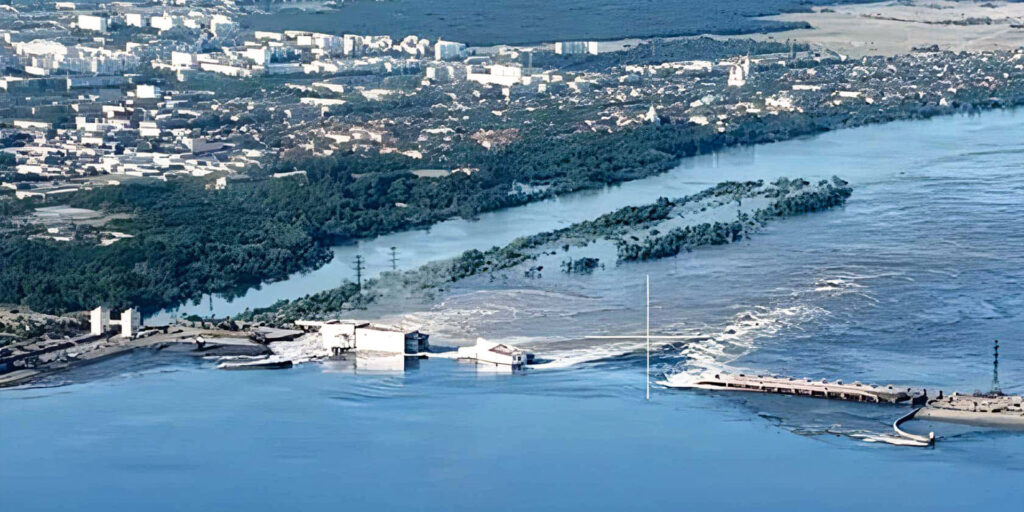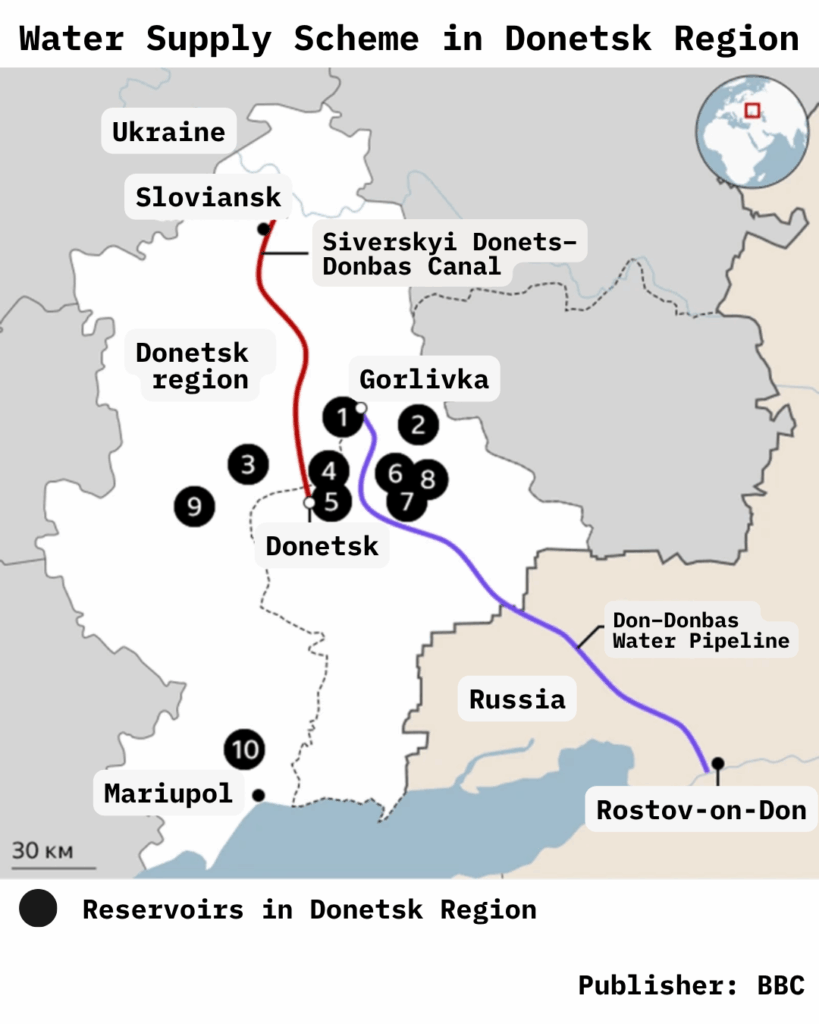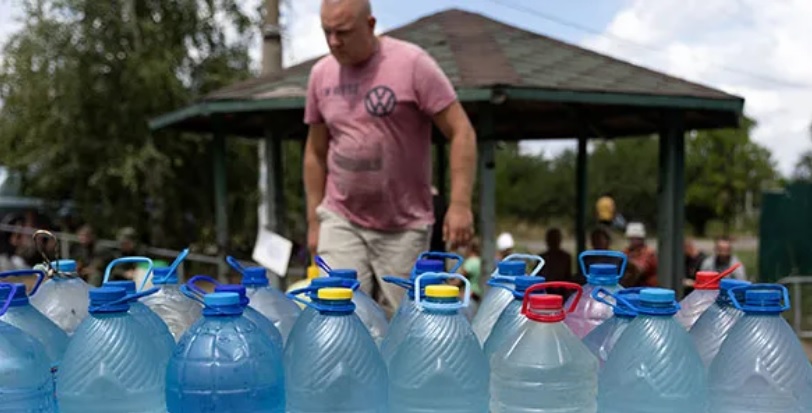Dehydration as a Weapon of War: Russia’s Environmental Crime
An environmental catastrophe is unfolding across the temporarily occupied territories of Ukraine. Russia, waging a war of aggression, has turned water scarcity into a weapon – a tool to pressure and destabilize entire regions. Its actions not only violate international humanitarian law but also inflict irreversible damage on the environment, human health, and ecosystems.
Across the occupied areas of Donetsk, Luhansk, Kherson, Zaporizhzhia regions and Crimea, there is a systemic lack of access to safe drinking water. In many towns and villages, infrastructure has been destroyed or severely degraded. Water supply systems are nonfunctional, and pumping stations cannot operate without adequate power. People are forced to survive by collecting rainwater, digging wells, or using delivered technical water, which is often unfit for drinking. Nearly 1 million people suffer from water shortages and poor water quality.
🌊 Crimea and the Kakhovka HPP: An Ecological Tragedy
A major turning point came in June 2023, when Russia blew up the Kakhovka Hydroelectric Power Plant. This act led to the rapid shallowing of the Kakhovka Reservoir, the destruction of a key water source for millions of people and agricultural producers, mass death of fish and wildlife, soil salinization, and a deepening water crisis in Crimea – despite years of Russian propaganda about “restoring water supply” to the peninsula.
The central part of Crimea suffered irreversible damage. Actively developed since the early 20th century, this region flourished after the construction of the North Crimean Canal (Dnieper–Crimean Canal). Thanks to consistent irrigation, the area saw thriving rice cultivation, vegetable farming, fodder crop production, and livestock farming, particularly dairy.

But after water supplies from the Dnipro river were cut off due to the mining of the dam and the destruction of the hydro plant, these sectors ceased to exist. Salinized soils, lack of irrigation, and the loss of arable land have made agriculture in the region ecologically and economically unviable.
Many experts and international organizations recognize this as ecocide: the deliberate destruction of a natural environment shaped over decades through human effort and engineering.
🧪 Unsanitary Conditions and a Threat to Public Health
By summer 2025, the water supply situation in the occupied areas of Donetsk and Luhansk reached a critical point. According to the official statement by the state utility “Water of Donbas,” water is supplied once every three days for just four hours, and in some locations it’s even less frequent – or completely unavailable. In cities like Torez, Russian-controlled since 2014, and the settlement of Krynychky, people have gone over a month without water.

The social reality of occupied Donbas is a hygienic disaster. Residents are adapting to the total lack of water. One employee of “Water of Donbas” told the BBC:
“My neighbor pushes a cart two kilometers to fetch water in a bottle. She wipes food off plates with toilet paper, rinses them lightly, and reuses that water to flush the toilet. We have ‘zero-waste water use’ — you boil eggs, wash your hands in the same water, and then use it again in the toilet.”
Water infrastructure – especially in lower-lying areas of Donetsk – is too degraded to pump water. And even when water is technically delivered, residents don’t receive it. As one Donetsk resident told the BBC:
“It’s either not there at all, or it’s murky with sediment. You can’t cook or wash with it. And yet, we’re billed as if it were drinking water.”
Since July 2025, water tariffs have risen, even though people receive no water – or worse, toxic liquid.

🌊 Exhausted Reservoirs
BBC analysis of satellite imagery confirms that 9 out of 10 major reservoirs in Donetsk Oblast have significantly shrunk. Importantly, 2025 was not an exceptionally hot year – the average temperature in July was 27°C. This shows the problem is not just climate-related – it is systemic.

Previously, the Siverskyi Donets–Donbas Canal provided the region’s main water supply. But after the start of Russia’s full-scale invasion in 2022, the canal was completely destroyed. “It was a unique hydroengineering structure built in the 1950s,” BBC sources say. “It supplied water to the entire region.”
In 2023, Russia hastily constructed a new pipeline, the Don–Donbas Canal, but it failed to deliver the needed water. Built with major violations and widespread corruption, the project is now at the center of criminal investigations. Russia’s Deputy Defense Minister Timur Ivanov is under arrest for embezzlement linked to the canal’s construction.
🔁 Simulation Instead of Solutions
With no viable plan, Russian authorities resort to performative responses: creating “emergency task forces,” adjusting tariffs, and sending water trucks from Moscow. But this is a simulation of care — not a solution. Without a functioning water pipeline and access to the Siverskyi Donets River, no bureaucratic task force can resolve Donbas’s water crisis.
The water crisis in occupied Donbas is the result of years of neglect, deliberate destruction of Ukrainian infrastructure, and cynical political theater by Russia. It’s a textbook example of how a humanitarian disaster becomes a weapon of war. Millions have been deprived of their basic right to water — not as a side effect, but as a strategic decision.
Ukraine and the international community must document these acts as crimes against humanity and the environment. And after de-occupation, we must not only restore what was lost — but also demand accountability from those who turned water into a weapon.




